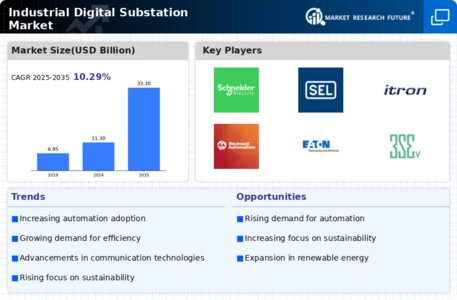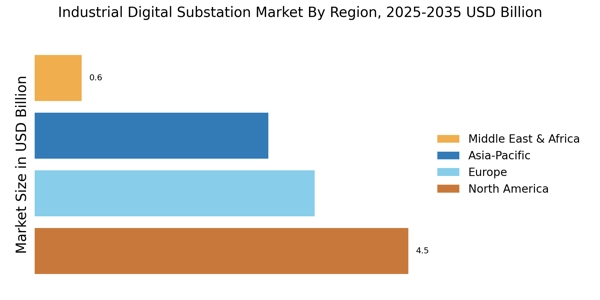Growing Demand for Energy Efficiency
The Industrial Digital Substation Market is experiencing a notable surge in demand for energy-efficient solutions. As industries strive to reduce operational costs and minimize environmental impact, the adoption of digital substations is becoming increasingly prevalent. These substations utilize advanced technologies such as smart grid systems and automation to optimize energy consumption. According to recent data, energy-efficient substations can reduce energy losses by up to 30%, making them an attractive option for energy-intensive industries. This trend is likely to continue as regulatory frameworks increasingly emphasize sustainability and energy efficiency, further propelling the growth of the Industrial Digital Substation Market.
Regulatory Support for Modernization
Regulatory bodies are increasingly advocating for the modernization of electrical infrastructure, which significantly influences the Industrial Digital Substation Market. Governments are implementing policies that encourage the adoption of digital technologies in substations to enhance grid reliability and resilience. For instance, initiatives aimed at reducing carbon emissions and promoting renewable energy integration are driving utilities to invest in digital substations. The market is expected to witness substantial growth, with projections indicating a compound annual growth rate of around 6% over the next five years. This regulatory support is likely to create a conducive environment for the expansion of the Industrial Digital Substation Market.
Advancements in Smart Grid Technology
The evolution of smart grid technology is a pivotal driver for the Industrial Digital Substation Market. Smart grids facilitate real-time monitoring and management of electricity distribution, enhancing reliability and efficiency. The integration of digital substations within smart grid frameworks allows for improved data analytics and predictive maintenance, which can lead to reduced downtime and operational costs. Recent estimates suggest that the smart grid market is projected to reach a valuation of over 100 billion dollars by 2026, indicating a robust growth trajectory. This advancement in technology is likely to catalyze further investments in the Industrial Digital Substation Market, as utilities and industries seek to modernize their infrastructure.
Rising Investment in Renewable Energy
The transition towards renewable energy sources is a critical factor propelling the Industrial Digital Substation Market. As countries commit to reducing their carbon footprints, there is a marked increase in investments in solar, wind, and other renewable energy projects. Digital substations play a crucial role in integrating these energy sources into the existing grid, ensuring stability and efficiency. Recent reports indicate that investments in renewable energy are expected to exceed 2 trillion dollars by 2030, highlighting the urgency for modernized infrastructure. This trend is likely to drive demand for digital substations, as they facilitate the seamless integration of renewable energy into the grid, thereby enhancing the Industrial Digital Substation Market.
Enhanced Data Management and Analytics
The Industrial Digital Substation Market is significantly influenced by advancements in data management and analytics. Digital substations generate vast amounts of data that can be leveraged for operational improvements and strategic decision-making. Enhanced data analytics capabilities allow for better forecasting, load management, and fault detection, which can lead to increased operational efficiency. The market for data analytics in the energy sector is projected to grow substantially, with estimates suggesting a value of over 20 billion dollars by 2025. This emphasis on data-driven decision-making is likely to foster further growth in the Industrial Digital Substation Market, as companies seek to harness the power of data to optimize their operations.


















Leave a Comment